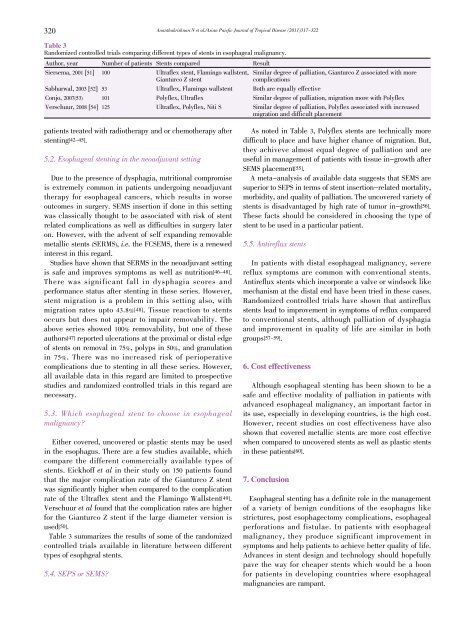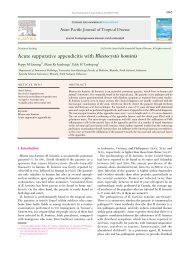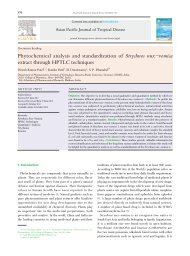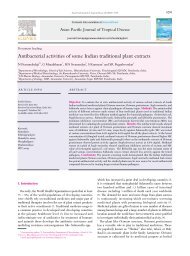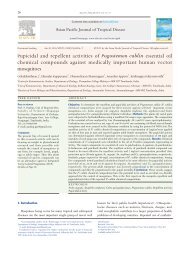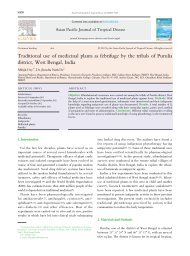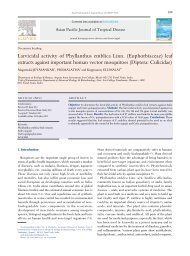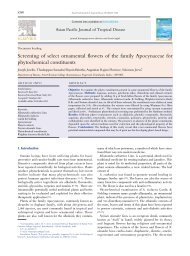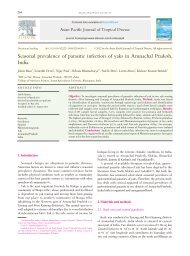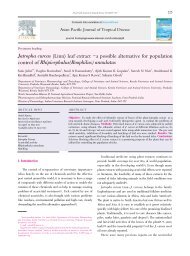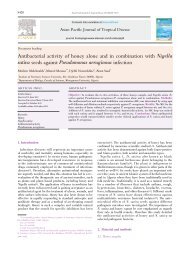Esophageal stents in benign and malignant diseases - Asian Pacific ...
Esophageal stents in benign and malignant diseases - Asian Pacific ...
Esophageal stents in benign and malignant diseases - Asian Pacific ...
You also want an ePaper? Increase the reach of your titles
YUMPU automatically turns print PDFs into web optimized ePapers that Google loves.
320<br />
patients treated with radiotherapy <strong>and</strong> or chemotherapy after<br />
stent<strong>in</strong>g[42-45].<br />
5.2. <strong>Esophageal</strong> stent<strong>in</strong>g <strong>in</strong> the neoadjuvant sett<strong>in</strong>g<br />
Due to the presence of dysphagia, nutritional compromise<br />
is extremely common <strong>in</strong> patients undergo<strong>in</strong>g neoadjuvant<br />
therapy for esophageal cancers, which results <strong>in</strong> worse<br />
outcomes <strong>in</strong> surgery. SEMS <strong>in</strong>sertion if done <strong>in</strong> this sett<strong>in</strong>g<br />
was classically thought to be associated with risk of stent<br />
related complications as well as difficulties <strong>in</strong> surgery later<br />
on. However, with the advent of self exp<strong>and</strong><strong>in</strong>g removable<br />
metallic <strong>stents</strong> (SERMS), i.e. the FCSEMS, there is a renewed<br />
<strong>in</strong>terest <strong>in</strong> this regard.<br />
Studies have shown that SERMS <strong>in</strong> the neoadjuvant sett<strong>in</strong>g<br />
is safe <strong>and</strong> improves symptoms as well as nutrition[46-48].<br />
There was significant fall <strong>in</strong> dysphagia scores <strong>and</strong><br />
performance status after stent<strong>in</strong>g <strong>in</strong> these series. However,<br />
stent migration is a problem <strong>in</strong> this sett<strong>in</strong>g also, with<br />
migration rates upto 43.8% [48]. Tissue reaction to <strong>stents</strong><br />
occurs but does not appear to impair removability. The<br />
above series showed 100% removability, but one of these<br />
authors[47] reported ulcerations at the proximal or distal edge<br />
of <strong>stents</strong> on removal <strong>in</strong> 75%, polyps <strong>in</strong> 50%, <strong>and</strong> granulation<br />
<strong>in</strong> 75%. There was no <strong>in</strong>creased risk of perioperative<br />
complications due to stent<strong>in</strong>g <strong>in</strong> all these series. However,<br />
all available data <strong>in</strong> this regard are limited to prospective<br />
studies <strong>and</strong> r<strong>and</strong>omized controlled trials <strong>in</strong> this regard are<br />
necessary.<br />
5.3. Which esophageal stent to choose <strong>in</strong> esophageal<br />
malignancy?<br />
Either covered, uncovered or plastic <strong>stents</strong> may be used<br />
<strong>in</strong> the esophagus. There are a few studies available, which<br />
compare the different commercially available types of<br />
<strong>stents</strong>. Eickhoff et al <strong>in</strong> their study on 150 patients found<br />
that the major complication rate of the Gianturco Z stent<br />
was significantly higher when compared to the complication<br />
rate of the Ultraflex stent <strong>and</strong> the Flam<strong>in</strong>go Wallstent[49].<br />
Verschuur et al found that the complication rates are higher<br />
for the Gianturco Z stent if the large diameter version is<br />
used[50].<br />
Table 3 summarizes the results of some of the r<strong>and</strong>omized<br />
controlled trials available <strong>in</strong> literature between different<br />
types of esophgeal <strong>stents</strong>.<br />
5.4. SEPS or SEMS?<br />
Ananthakrishnan N et al./<strong>Asian</strong> Paicfic Journal of Tropical Disease (2011)317-322<br />
Table 3<br />
R<strong>and</strong>omized controlled trials compar<strong>in</strong>g different types of <strong>stents</strong> <strong>in</strong> esophageal malignancy.<br />
Author, year Number of patients Stents compared Result<br />
Siersema, 2001 [51] 100 Ultraflex stent, Flam<strong>in</strong>go wallstent, Similar degree of palliation, Gianturco Z associated with more<br />
Gianturco Z stent<br />
complications<br />
Sabharwal, 2003 [52] 53 Ultraflex, Flam<strong>in</strong>go wallstent Both are equally effective<br />
Conjo, 2007(53) 101 Polyflex, Ultraflex Similar degree of palliation, migration more with Polyflex<br />
Verschuur, 2008 [54] 125 Ultraflex, Polyflex, Niti S Similar degree of palliation, Polyflex associated with <strong>in</strong>creased<br />
migration <strong>and</strong> difficult placement<br />
As noted <strong>in</strong> Table 3, Polyflex <strong>stents</strong> are technically more<br />
difficult to place <strong>and</strong> have higher chance of migration. But,<br />
they achiveve almost equal degree of palliation <strong>and</strong> are<br />
useful <strong>in</strong> management of patients with tissue <strong>in</strong>-growth after<br />
SEMS placement[55].<br />
A meta-analysis of available data suggests that SEMS are<br />
superior to SEPS <strong>in</strong> terms of stent <strong>in</strong>sertion-related mortality,<br />
morbidity, <strong>and</strong> quality of palliation. The uncovered variety of<br />
<strong>stents</strong> is disadvantaged by high rate of tumor <strong>in</strong>-growth[56].<br />
These facts should be considered <strong>in</strong> choos<strong>in</strong>g the type of<br />
stent to be used <strong>in</strong> a particular patient.<br />
5.5. Antireflux <strong>stents</strong><br />
In patients with distal esophageal malignancy, severe<br />
reflux symptoms are common with conventional <strong>stents</strong>.<br />
Antireflux <strong>stents</strong> which <strong>in</strong>corporate a valve or w<strong>in</strong>dsock like<br />
mechanism at the distal end have been tried <strong>in</strong> these cases.<br />
R<strong>and</strong>omized controlled trials have shown that antireflux<br />
<strong>stents</strong> lead to improvement <strong>in</strong> symptoms of reflux compared<br />
to conventional <strong>stents</strong>, although palliation of dysphagia<br />
<strong>and</strong> improvement <strong>in</strong> quality of life are similar <strong>in</strong> both<br />
groups[57-59].<br />
6. Cost effectiveness<br />
Although esophageal stent<strong>in</strong>g has been shown to be a<br />
safe <strong>and</strong> effective modality of palliation <strong>in</strong> patients with<br />
advanced esophageal malignancy, an important factor <strong>in</strong><br />
its use, especially <strong>in</strong> develop<strong>in</strong>g countries, is the high cost.<br />
However, recent studies on cost effectiveness have also<br />
shown that covered metallic <strong>stents</strong> are more cost effective<br />
when compared to uncovered <strong>stents</strong> as well as plastic <strong>stents</strong><br />
<strong>in</strong> these patients[60].<br />
7. Conclusion<br />
<strong>Esophageal</strong> stent<strong>in</strong>g has a def<strong>in</strong>ite role <strong>in</strong> the management<br />
of a variety of <strong>benign</strong> conditions of the esophagus like<br />
strictures, post esophagectomy complications, esophageal<br />
perforations <strong>and</strong> fistulae. In patients with esophageal<br />
malignancy, they produce significant improvement <strong>in</strong><br />
symptoms <strong>and</strong> help patients to achieve better quality of life.<br />
Advances <strong>in</strong> stent design <strong>and</strong> technology should hopefully<br />
pave the way for cheaper <strong>stents</strong> which would be a boon<br />
for patients <strong>in</strong> develop<strong>in</strong>g countries where esophageal<br />
malignancies are rampant.


